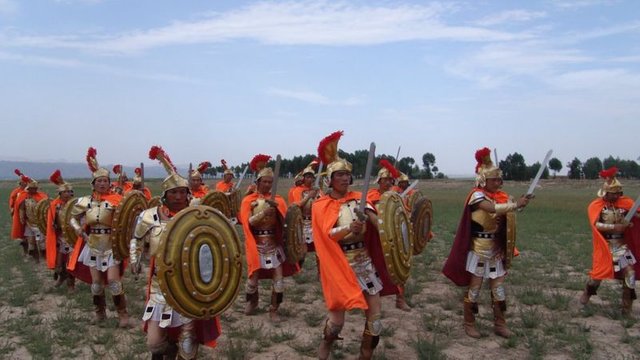Did the Roman Legion really settle in China?

Although the mystery of whether the Lili people are descended from the ancient Roman legions has not yet been revealed, it has attracted the attention of researchers and tourists
That sound must be frightening. A Roman legion has about 5,000 people, 5,000 people have 10,000 feet, and each foot wears military slippers with nail-heads. One shoe is clanging on the stone road. Ten thousand must be deafening. It shows to the enemies of the empire: prepare Challenge it.
Two thousand years have passed, and a mystery left by the Roman Legion remains unsolved.
This starts with the Battle of Calle. Krasu, one of the three giants of the Roman Empire, launched an offensive against its old rival, the Parthian Empire (located near today's Turkey, called the Parthian Empire in Western history books), and suffered a complete failure, and Kalai became Krasu's Waterloo. On that day in 53 BC, Krasu was beheaded by an enemy soldier...
The Battle of Calle was the worst military defeat in the history of the Roman Empire. Thousands of Roman soldiers who survived the death were captured and transported to the east. Although the Roman poet Horace once wrote that some Roman legionaries later married Parthian women, their true fate remains a mystery.
In the mid-20th century, Homer Dubs, an expert on China studies in Oxford, proposed that the Roman legionaries traveled farther east than previously thought, and they were likely to travel thousands of miles to the east.
A few years after the Battle of Calle, war broke out in a city in China. On the battlefield, some mercenaries’ combat behaviors are unprecedented in China: they chain their shields tightly to resist the enemy. Such a defensive formation is called "fish scale formation" in Chinese. Although the theory of fish scale formation can only be seen in Chinese literature, the method of chaining shields is one of the typical actions and tricks of the Roman legion, and it is called the tortoise shell formation.
At almost the same time, a small city named Lilu (Roman in ancient Chinese) was established in northwestern China. Did the Roman Legionnaires who survived the Battle of Calle settle here?
Conjecture is still conjecture. Perhaps one day, we will find the truth, where the deafening Roman troop stops.
Recommended by: Catherine Nixey, historian and writer
Is the Trojan War a historical fact or a fiction?

Trojan Horse Massacre: Did the Trojan War really happen?
Trojan Horse Massacre: Did the Trojan War really happen?
The most profound and greatest unsolved mystery in the ancient history of mankind must be whether the Trojan War actually happened.
According to Homer’s epic poem "Iliad", the war between the Greeks led by King Agamemnon of Mycenae and the Trojans led by King Piam took place in the late Bronze Age and lasted for 10 years.
In the eyes of many Greeks, including some reputable historians, the Trojan War is a myth, but an epoch-making event in ancient Greek history.
In the second half of the fifth century BC, Herodotus, the "father of history" pointed out that the Trojan War occurred nearly 800 years before his era. The mathematician Eratosthenes (Eratosthenes) more specifically, the war occurred in 1184 or 1183 BC.
Some of the details described in the "Iliad" do coincide with this historical period. For example, the palace of King Piam is reminiscent of the luxurious and magnificent palaces built by the Mycenae on the Peloponnese Peninsula in southern Greece.
However, Homer’s epic is not a historical record. So in what sense, the Trojan War described by Homer may be real?
To discover the city of Troy in Homer’s epic, at the end of the 19th century, the wealthy Prussian businessman Heinrich Schliemann went to present-day Turkey. In Hisarlik on the west coast, Schliemann dug up the right spot. Most historians now believe that the ancient city of Troy was in Hisharic.
Archaeological excavations also found some arrows and human bones, which can be traced back to the war years described by Homer; in addition, the remains of the fire were also found. Although there is not much evidence, it is helpful to those who believe that the Trojan War actually existed. In addition, there is also an inscription of the Hittites, an ancient nation in central Turkey, describing a dispute about Troy, which they called "Wilusa" (Wilusa).
These evidences, coupled with ancient historians' determinations, will undoubtedly make us take seriously the possibility of a war in Troy in the late Bronze Age.
However, even if there is a war, the truth must be very different from Homer's description. For example, in such a small area, it is difficult to imagine that the war will last for 10 years; God will certainly not go to the battlefield to intervene in the war. But is Homer’s epic to commemorate the historical events of Troy and to sublimate its art?
We still can't draw conclusions. At least for now, the truth of the Trojan War is still far away from us.
Recommended by: Daisy Dunn, writer and critic.